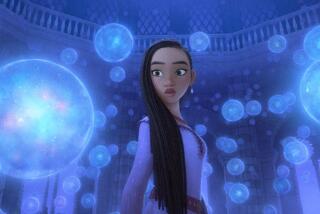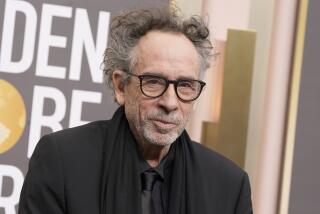Review: ‘Alice in Wonderland’
- Share via
One pill makes you larger and one pill makes you small, and the pills Tim Burton gives you don’t do very much at all.
With apologies to Jefferson Airplane’s “White Rabbit,” that more or less sums up “Alice in Wonderland,” the director’s middling new version of the Lewis Carroll tale. It has its successful moments but it’s surprisingly inert overall, more like a Burton derivative than something he actually did himself.
Through no fault of its own, “Alice” also has the misfortune of being the first major 3-D release to come out after the “Avatar” revolution, and when you add in that Burton chose to shoot in 2-D and have the footage converted, it inevitably plays like one of the last gasps of the old-fashioned ways of doing things.
Especially old-school is the framing device devised by veteran Disney animation screenwriter Linda Woolverton (“Beauty and the Beast,” “The Lion King”). In this version, Alice is introduced as a 6-year-old girl troubled by visions of falling down a hole and “seeing all these creatures,” episodes her kindly dad assures her are nothing but dreams.
Then it’s 13 years later and Alice is a pouty young woman (Australian actress Mia Wasikowska) headed for a posh garden party with her mother. Alice is a bit of a rebel (she doesn’t wear a corset!) and though she doesn’t know it, she’s on the way to what her family hopes will be her engagement party.
But once we meet Alice’s intended, a complete twit named Hamish, we know that marriage is not going to happen, and a good thing too, for this part of the film is so tedious we are all but begging for the escape the rabbit hole provides, especially because it serves as a portal to Burton’s inventive mind.
Alice is soon desperate to flee as well and, following the traditional white rabbit (voiced by Michael Sheen), she hurtles down the hole and confronts a world of wonders where animals talk and even flowers speak their minds.
Given the strength of Burton’s imagination, it’s not surprising that many of these creatures are engaging, especially if, like that rabbit, they are voiced by top British actors.
The unsettling Cheshire Cat ( Stephen Fry) is hard to forget, as are Absolem the Blue Caterpillar ( Alan Rickman), Bayard the Bloodhound (Timothy Spall) and fright legend Christopher Lee as the dread Jabberwocky.
Rather less satisfying is the script’s notion that the creatures spend much of their time bickering as to whether this Alice is the same person who came down the rabbit hole a decade earlier and, if she is, whether she has “lost her muchness” in the intervening years. They even give her a hard time for getting the name of the location wrong: It’s Underland, she’s disdainfully told, not Wonderland.
These disputes soon become tiresome, even if one of Alice’s champions is played by Johnny Depp. His Mad Hatter is a genuine fashionista whom we get to see designing wacky headgear like there is no tomorrow. There’s no denying Depp’s gifts and abilities, but this performance feels both indulgent and something we’ve all seen before.
What is even more unfortunate is the film’s attempt to turn itself into an Underland version of “The Lord of the Rings,” complete with massed forces of good and evil inevitably headed toward a sadly generic CGI battle to end all battles.
Inspiring the powers of light is the White Queen ( Anne Hathaway), while heading the wicked side is her sister, the dyspeptic Red Queen ( Helena Bonham Carter) and Stayne, the Knave of Hearts ( Crispin Glover), her 7-foot-6 top general.
All these people are in a lather about Alice because it turns out that a venerable document called the Oraculum has foretold that Alice will return to lead the forces of light and slay the dark side’s champion, the mighty Jabberwocky.
Alice, of course, insists she is the nonviolent sort and likely to do no such thing but, frankly, what does she know?
With those battle scenes in place to please the boys, Burton and company have taken special care to provide pictures of Alice as a warrior princess in full Joan of Arc armor as a female empowerment icon for the girls in the audience.
While that kind of thing is always in short supply, it would be nicer if that image -- and the movie as a whole -- felt less like corporate moves and more like situations that came from the heart.
More to Read
The biggest entertainment stories
Get our big stories about Hollywood, film, television, music, arts, culture and more right in your inbox as soon as they publish.
You may occasionally receive promotional content from the Los Angeles Times.










